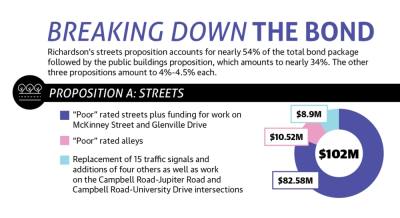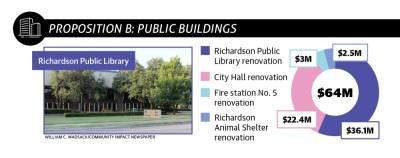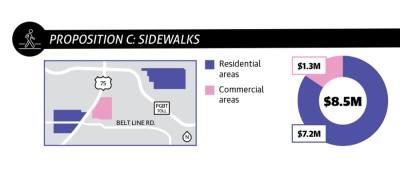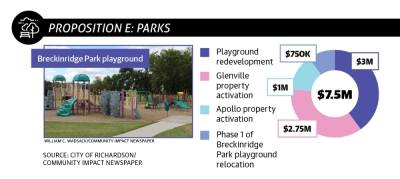More than half of the bond funding is dedicated to street improvements, including reconstruction of aging roadways and alleys.
“We’re really focusing on rehabilitating some of our major thoroughfares,” Deputy City Manager Don Magner said. “[We are also] reinvesting in neighborhood streets and alleys to make sure that the city is making the same kind of commitment to investment in residential areas that our homeowners are.”
Renovation projects for public buildings, such as City Hall and the Richardson Public Library, make up more than a third of bond funds. The remaining propositions cover work planned for sidewalks, drainage and parks.
If the bond measures are approved, Magner said there would be no change to the city’s property tax rate.
“The funding that’s proposed in this bond program is largely due to existing debt being paid off and some anticipated growth in our property valuation,” Magner said.
Forming the bond
Magner said much of Richardson’s roadway infrastructure has a useful life of around 25 years. More than 70% of the city’s streets are at least 40 years old.
Richardson’s annual maintenance program has kept many streets in good and satisfactory condition, Magner said. But streets categorized by a 2020 citywide analysis as poor or fair have continued to decline since the last analysis in 2014.
Many cities in Dallas-Fort Worth are dealing with aging infrastructure, according to Jeffrey Neal, senior program manager with the North Central Texas Council of Governments. The council monitors infrastructure and works with local governments to help ensure continued maintenance of roadways.
“You’re now getting to that time where [aging cities] have to really begin thinking about major rehabilitation or replacement,” Neal said. “Even though those roads may not need to be widened, it’s remaining very important for those facilities to be functional.”
Richardson also needs to rehabilitate some of its most used public buildings, Magner said.
Library Director Jennifer Davidson said bond funds would be used to address issues with electricity, plumbing and air conditioning in the building. The library’s restrooms and staircases would also be consolidated into one location to open up more space for staff, she said.
“Because of the infrastructure [work on] the plumbing and electricity, we can’t close a floor and stay [in the building during the renovations],” Davidson said.
While a temporary location has not been chosen for the move, Davidson said it is expected to be a fraction of the size of the library.
Magner said City Hall will receive similar rehabilitation work under the bond program. City staff said the Richardson Civic Center, which is part of the City Hall building, will discontinue operations if the public buildings proposition is approved.
During fiscal year 2018-19, which was the last full fiscal year before the COVID-19 pandemic began, the city spent more than $1 million to operate the center. It generated less than $355,000 in revenue during that fiscal year.
Much of the existing Civic Center space will be used to expand City Hall. The only events that would still be hosted in the building’s existing meeting rooms are municipal events and those done in partnership with the city.
Addressing infrastructure
In addition to replacing and repairing residential sidewalks in the city’s northeast and southwest quadrants, Magner said this bond package includes a new commercial sidewalk program that will begin with The Innovation Quarter.
Richardson also plans to invest bond funds in nine neighborhood parks.
“The life cycle of a playground can be as much as 15-20 years, and so these are the ones that essentially are just next on the list [for replacement],” Director of Parks and Recreation Lori Smeby said.
Bond funds would also be used to prepare a pair of city-owned fields for future use, she said. One of those is a 26-acre property at the corner of North Plano and Apollo roads. The other is across from Glenville Park near East Spring Valley and South Plano roads.
The drainage proposition would fund erosion work at Prairie, Huffhines and Chestnut creeks, as well as add a detention basin at Cottonwood Creek.
Planning for the future
Each bond proposition is voted on separately. If voters approve the package Nov. 2, Magner said the next two years are likely to be spent designing and finalizing plans. However, residents could see sidewalk projects begin in 2022, he said.
Debt from the bond would be sold over a five-year period beginning in fiscal year 2021-22. Since funds would be spread out over those five years, Magner said some projects in the bond would not be completed in that timeframe.
“We’ve got to make sure we get the money in the bank to be able to pay for the various projects,” he said. “We’ll be really trying to have a diverse set of projects underway as soon as the bond program is passed.”











